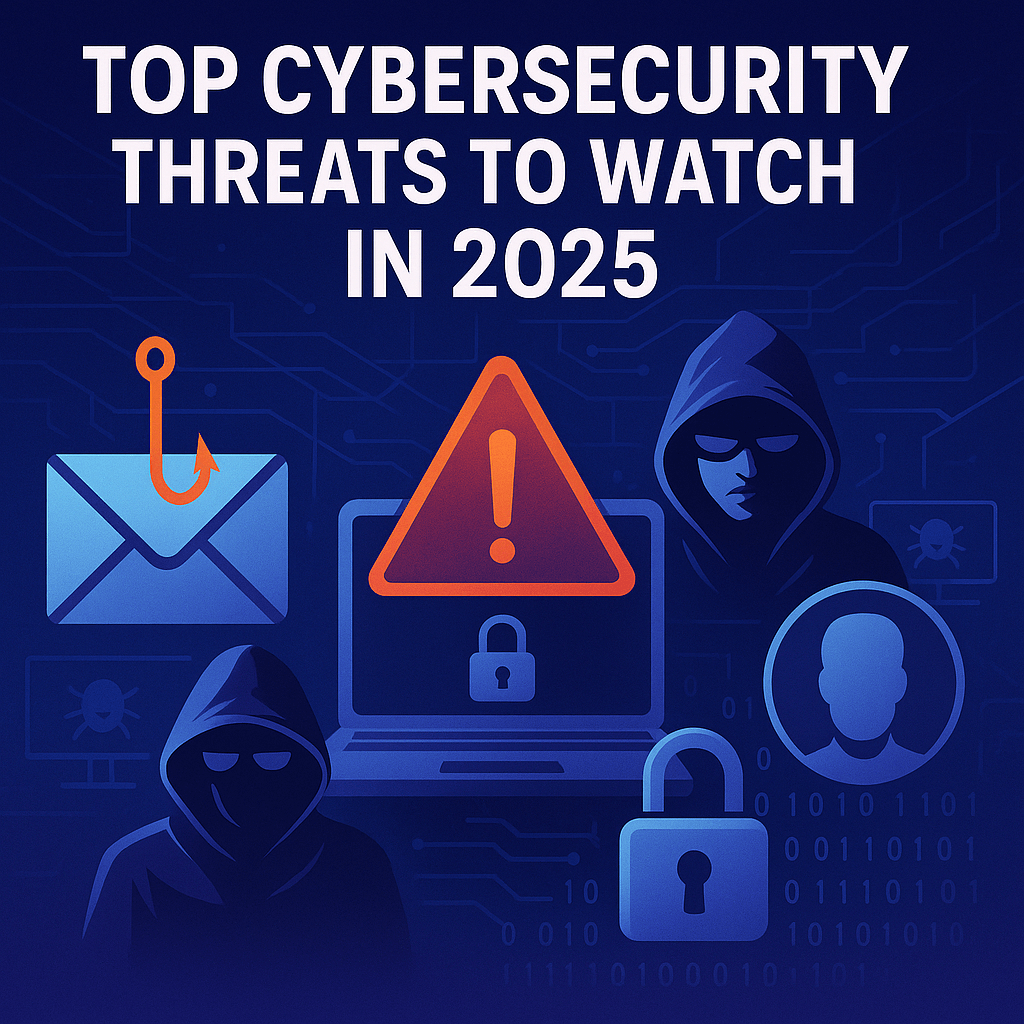
Top Cybersecurity Threats to Watch in 2025
By InfoDefenders Editorial Team · July 30, 2025 · Cybersecurity Basics
Why 2025 Will Be a Defining Year in Cybersecurity
The digital battlefield is evolving. In 2025, organizations—especially small and mid-sized businesses (SMBs)—face more sophisticated, faster-moving cyber threats than ever before. Adversaries are embracing AI, targeting supply chains, and exploiting weak identity controls. At the same time, defenders must navigate a rapidly expanding threat surface: hybrid workforces, shadow IT, and evolving compliance mandates.
This article explores the top cybersecurity threats to watch in 2025, offering actionable insights to protect your team, tools, and customers.
1. AI-Powered Phishing & Deepfakes
The Threat:
In 2025, phishing emails are no longer riddled with typos. Thanks to large language models (LLMs), attackers can craft hyper-personalized, error-free messages that mimic your colleagues, vendors, and executives.
Worse, AI-generated voice clones and deepfake videos now enable highly convincing social engineering:
-
Fake CEO requesting urgent wire transfers.
-
Audio of an executive "authorizing" access.
-
HR impersonation to harvest credentials.
Impact on SMBs:
SMBs are prime targets due to limited verification processes and under-resourced IT teams. A single voice spoofing attack can lead to devastating financial or reputational damage.
Mitigation:
-
Deploy phishing-resistant MFA (e.g. FIDO2, passkeys).
-
Train users on AI phishing simulations quarterly.
-
Use identity verification procedures for sensitive requests.
2. Supply Chain Attacks: A Growing Vector
The Threat:
Attackers are bypassing hardened targets by breaching their vendors, MSPs, or SaaS providers—a tactic now referred to as “island hopping.”
High-profile examples include:
-
SolarWinds (compromised updates)
-
MOVEit (zero-day exploited by Cl0p ransomware)
-
3CX supply chain compromise
Why It’s Rising:
As SMBs increasingly rely on outsourced IT, managed security services, and cloud providers, their exposure to third-party risk escalates.
Mitigation:
-
Demand Software Bill of Materials (SBOMs) from vendors.
-
Review third-party incident response policies.
-
Implement vendor segmentation in your environment.
3. Shadow SaaS and Unmanaged Cloud Risk
The Threat:
Employees often spin up new SaaS tools without IT’s knowledge—uploading sensitive data to tools like Trello, Notion, or ChatGPT plugins.
These “Shadow IT” services:
-
Bypass security review
-
Store customer or internal data in unmonitored locations
-
Lack DLP, encryption, or identity controls
Impact on SMBs:
Many breaches begin with unauthorized data in cloud apps that aren’t on the radar of IT or compliance.
Mitigation:
-
Deploy SaaS discovery tools (e.g. Wing Security, Netskope, DoControl)
-
Create an approved app registry and educate employees
-
Use CASB/DLP tools to restrict sensitive data movement
4. Ransomware-as-a-Service (RaaS) 2.0
The Threat:
Ransomware is now a business model. Sophisticated groups like LockBit and BlackCat offer affiliate-based “kits” with 24/7 support, enabling non-technical criminals to launch attacks.
In 2025, the stakes are higher:
-
Triple extortion (encrypt, exfiltrate, and DDoS)
-
Targeting backups and disaster recovery systems
-
Focusing on legal, healthcare, and education SMBs
Mitigation:
-
Use immutable, offsite backups with limited delete permissions
-
Implement microsegmentation to prevent lateral movement
-
Test incident response and restoration regularly
5. Identity-Based Attacks: MFA Fatigue & Token Theft
The Threat:
Adversaries are increasingly bypassing MFA by:
-
MFA fatigue attacks: bombarding users with push requests until they approve out of frustration.
-
Session token theft: stealing browser session cookies to bypass logins entirely (e.g., Lumma Stealer).
These methods undermine traditional IAM defenses and make endpoint hygiene even more critical.
Mitigation:
-
Enforce phishing-resistant MFA (not SMS or app-based push alone)
-
Deploy browser isolation or kill switch for stolen sessions
-
Rotate session tokens regularly and detect unusual locations
6. API and Web App Vulnerabilities
The Threat:
APIs are the backbone of modern apps—and attackers know it. Poorly secured or undocumented APIs can expose customer data, user credentials, and backend systems.
OWASP API Top 10 risks (e.g., Broken Object Level Authorization, Excessive Data Exposure) are being exploited at scale.
Mitigation:
-
Inventory all APIs, including internal/public/partner
-
Conduct continuous security testing (DAST, SAST, fuzzing)
-
Enforce authentication, rate limiting, and input validation
7. Nation-State Attacks on Critical SMBs
The Threat:
Nation-state actors are no longer just targeting defense contractors or government agencies—they’re going downstream.
In 2025, SMBs in manufacturing, telecom, logistics, and critical infrastructure are in the crosshairs of cyber espionage and supply chain disruption campaigns.
Common tactics:
-
DNS spoofing
-
Watering hole attacks
-
Fake firmware updates
Mitigation:
-
Use geo-restricted DNS and threat intel integrations
-
Enforce firmware validation and signed updates
-
Implement segmented networks for OT vs. IT environments
8. Insider Threats in a Hybrid World
The Threat:
Remote and hybrid work environments increase the risk of insider misuse—either unintentional (e.g., syncing sensitive data to personal Google Drive) or malicious (e.g., disgruntled employees exfiltrating data).
Common Vectors:
-
USB exfiltration
-
Personal cloud storage
-
Unmonitored VPN or RDP access
Mitigation:
-
Monitor User Behavior Analytics (UBA)
-
Use data loss prevention (DLP) tools on endpoints and browsers
-
Create clear offboarding procedures and access revocation workflows
2025 Trends You Can’t Ignore
-
Quantum-readiness: Forward-thinking orgs are starting to explore quantum-resistant encryption algorithms.
-
Regulatory pressure: New mandates (like SEC incident reporting or EU’s NIS2 directive) demand tighter logging and disclosure controls.
-
Autonomous SOCs: AI-powered threat detection platforms are accelerating alert triage and automated response in lean security teams.
Final Thoughts: How to Stay Ahead
In 2025, cybersecurity isn’t just an IT issue—it’s a business imperative.
To stay resilient:
-
Invest in identity, endpoint, and API protection
-
Monitor for behavioral anomalies and insider risk
-
Harden your cloud, SaaS, and third-party environments
-
Maintain visibility and governance across tools and users
Small and mid-sized businesses don’t need enterprise budgets to defend against modern threats—they need clarity, coverage, and commitment.
InfoDefenders can help. Whether you’re looking to assess risk, train your team, or implement AI-assisted defenses, we offer tools and guidance tailored to your size and sector.